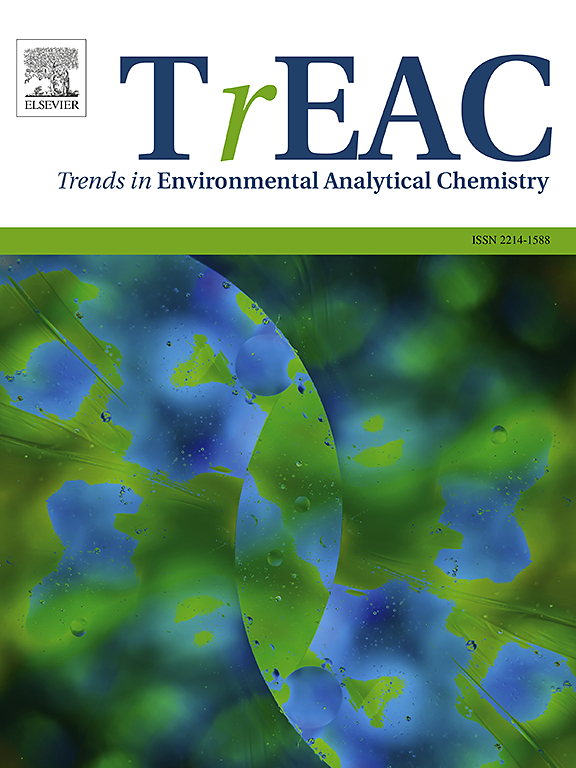Insights into surface and chemical interactions in electrochemical probing of Diazinon: A comprehensive review on current trends, challenges, and perspectives
IF 13.4
2区 化学
Q1 CHEMISTRY, ANALYTICAL
引用次数: 0
Abstract
The widespread use of organophosphate pesticides, particularly Diazinon, raises significant concerns about environmental contamination and human health due to their high toxicity and potential chemical discharge into water systems. Effective monitoring of Diazinon levels is crucial for minimizing risks associated with agricultural runoff and public safety. Hence, an enormous demand exists for developing highly accurate, rapid, and sensitive Diazinon detection systems. One such rapid and sensitive Diazinon detection system is an electrochemical approach. This review highlights the recent trends and advancements in the electrochemical sensing of Diazinon, along with the critical challenges and future perspectives. The underlying mechanisms in the electrochemical sensing of Diazinon, along with the interactions in the electrode-electrolyte interface, electrode surface modifications with various functional nanomaterials, electron transfer rate reactions, and selectivity of the modified electrodes towards Diazinon have been emphasized. Versatile electrochemical sensors in the context of enzyme-based and enzyme-free sensors, including CNT-enabled sensors, aptasensors, impedimetric sensors, molecularly imprinted polymer sensors and hybrid electrochemical sensors, have been highlighted along with the specific role in the enhancement of electrochemical sensing of Diazinon. This review opens up new insights into elucidating the recent advancements, critical challenges, and strategies in electrochemical probing of Diazinon, which facilitates significant advancements in sensor technology. This review examines current capabilities and future directions and contributes to ongoing environmental protection and public health safety efforts through effective pesticide monitoring strategies.
二嗪农电化学探测中表面和化学相互作用的深入研究:对当前趋势、挑战和前景的全面回顾
有机磷农药,特别是二嗪农的广泛使用,引起了对环境污染和人类健康的重大关切,因为它们具有高毒性,并可能向水系统排放化学物质。有效监测二氮肼水平对于尽量减少与农业径流和公共安全有关的风险至关重要。因此,对开发高精度、快速、灵敏的二嗪农检测系统有着巨大的需求。一种快速、灵敏的二嗪农检测系统是电化学方法。本文综述了二嗪农电化学传感的最新趋势和进展,以及主要挑战和未来展望。强调了二嗪农的电化学传感的潜在机制,以及电极-电解质界面的相互作用,电极表面与各种功能纳米材料的修饰,电子转移速率反应以及修饰电极对二嗪农的选择性。在酶基和无酶传感器的背景下,多种电化学传感器,包括碳纳米管传感器、适体传感器、阻抗传感器、分子印迹聚合物传感器和混合电化学传感器,随着在增强二嗪农电化学传感中的具体作用而受到重视。这篇综述为阐明二嗪农电化学探测的最新进展、关键挑战和策略开辟了新的见解,从而促进了传感器技术的重大进步。本综述审查了目前的能力和未来的方向,并通过有效的农药监测战略为正在进行的环境保护和公共卫生安全工作作出贡献。
本文章由计算机程序翻译,如有差异,请以英文原文为准。
求助全文
约1分钟内获得全文
求助全文
来源期刊

Trends in Environmental Analytical Chemistry
Chemistry-Analytical Chemistry
CiteScore
21.20
自引率
2.70%
发文量
34
审稿时长
44 days
期刊介绍:
Trends in Environmental Analytical Chemistry is an authoritative journal that focuses on the dynamic field of environmental analytical chemistry. It aims to deliver concise yet insightful overviews of the latest advancements in this field. By acquiring high-quality chemical data and effectively interpreting it, we can deepen our understanding of the environment. TrEAC is committed to keeping up with the fast-paced nature of environmental analytical chemistry by providing timely coverage of innovative analytical methods used in studying environmentally relevant substances and addressing related issues.
 求助内容:
求助内容: 应助结果提醒方式:
应助结果提醒方式:


